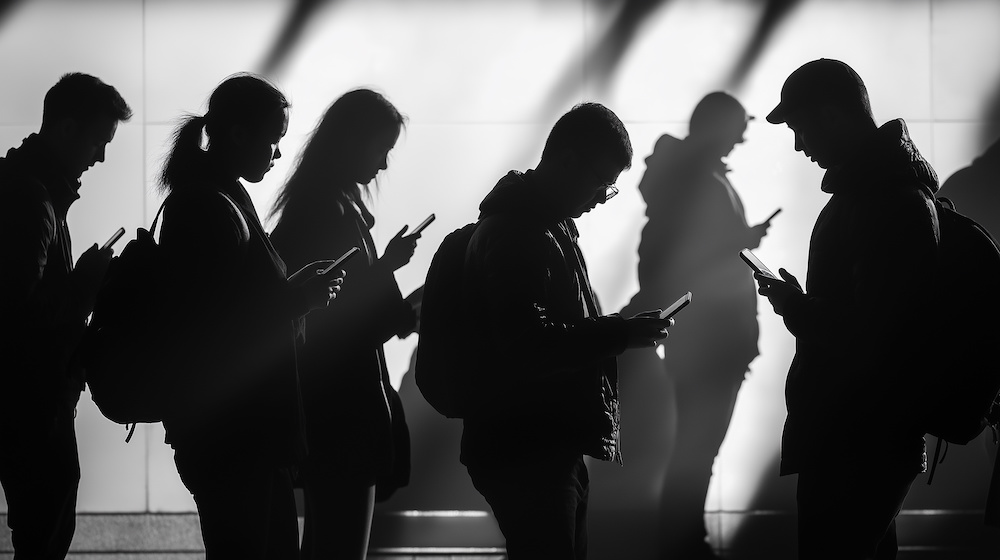We’ve all been there — a stunning view, a meaningful moment, or an opportunity for real connection, interrupted by… another glance at a smartphone.
It happened to me twice recently:
- An old neighbor posted a photo from a family ski trip in Tahoe. The shot was taken at the very top of a slope, with snow-capped mountains stretching endlessly into the horizon. And right there in the foreground? Their teenage son, head down, eyes locked on his phone.
- On my Uncle’s boat, while one young relative was soaking up the sunshine, I looked over to see another one of them scrolling away. Not taking in the fresh air, the water, the laughter — just focused on whatever was on the screen.
These moments are more than just funny anecdotes. They’re daily reminders that smartphone overuse is quietly eroding our ability to be present — with each other and with ourselves.
The Impact of Smartphone Overuse on Mental Wellbeing
Smartphones are incredible tools. They keep us connected, informed, and entertained. But without boundaries, they can also:
- Increase stress and anxiety by keeping our brains in a constant state of alert
- Disrupt sleep quality by exposing us to blue light and mental stimulation late at night
- Reduce face-to-face social interaction and emotional connection
- Lower productivity and focus through frequent interruptions
- Create mental fatigue from an endless flow of notifications, emails, and social media updates
The science backs this up. Studies have shown that heavy smartphone use can impact memory, attention span, and even our ability to regulate emotions. Over time, these effects don’t just harm our personal lives — they can spill into our work, our relationships, and our health.
From Awareness to Action: How GoPivot Tackles Digital Overload
At GoPivot, we know that wellbeing is multi-dimensional. It’s not just about physical activity or nutrition — it’s also about protecting and improving mental and emotional health.
That’s why we created one of our most popular wellness program initiatives: the Digital Detox Challenge. This challenge encourages participants to take small, consistent steps to reclaim their attention, reduce unnecessary screen time, and rebuild healthy boundaries with technology.
The beauty of the challenge is that it’s approachable. You don’t need to give up your phone altogether. Instead, you focus on intentional actions that create lasting change.
Popular Digital Detox Challenge Actions
Here’s a mix of our client favorites — plus a few new ones to try:
- Unsubscribe & Declutter – Unsubscribe from 10+ unnecessary email lists and delete spam.
- Clean Up Your Apps – Delete at least 5 apps you no longer use.
- Organize Your Home Screen – Move distracting apps off your home screen or into folders.
- Turn Off Notifications – Disable non-essential alerts to reduce interruptions and mental noise.
- Declutter Your Contacts – Remove outdated or duplicate contacts.
- Set Screen Time Limits – Use your device’s settings to cap time on social media or entertainment.
- Go Device-Free for an Evening – Try a “No-Screen” rule after 8 PM at least once a week.
- Delete Old Photos & Files – Remove unnecessary screenshots, duplicates, and outdated downloads.
- Unfollow & Unfriend – Cut ties with accounts that no longer inspire or add value.
- Create a Tech-Free Morning Routine – Start your day phone-free for at least 30 minutes.
- Designate Tech-Free Zones – Keep devices out of certain spaces like the dining room or bedroom.
- Practice Mindful Scrolling – Pause before opening an app and ask: “Why am I doing this right now?”
- Schedule Social Media Days – Check social platforms only on certain days of the week.
- Replace One Digital Habit with a Physical One – Read a book, take a walk, or call a friend instead of scrolling.
Why Digital Detox Works for Employee Wellness Programs
When we run the Digital Detox Challenge for our clients, we consistently see:
- Higher engagement rates in wellness programs
- Improved team connection as people interact more face-to-face
- Better work-life balance with clearer boundaries between work and personal time
- Reduced stress levels reported in post-challenge surveys
For employers, the benefits go beyond employee satisfaction. Reducing screen fatigue can lead to sharper focus, better decision-making, and higher productivity — all of which impact the bottom line.
Small Shifts, Major Results
You don’t have to throw your phone in a drawer forever. The key is awareness and intentionality. By taking small, manageable steps — unsubscribing from emails, setting app limits, designating no-phone hours — you retrain your brain to prioritize the present.
Because here’s the truth: when you disconnect from your phone, you reconnect with your life.
And at GoPivot, we believe that’s a win worth investing in.
If your organization is ready to explore creative, measurable ways to improve employee mental wellbeing, boost engagement, and reduce digital fatigue, let’s talk.
👉 Schedule a Demo to learn more about how the Digital Detox Challenge can work for your team.

